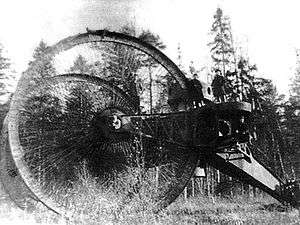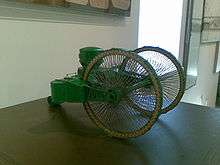Tsar Tank
The Tsar Tank (Russian: Царь-танк), also known as the Netopyr' (Нетопырь) which stands for Pipistrellus (a genus of bat) or Lebedenko Tank (танк Лебеденко), was an unusual Russian armoured vehicle developed by Nikolai Lebedenko (Николай Лебеденко), Nikolai Zhukovsky (Николай Жуковский), Boris Stechkin (Борис Стечкин), and Alexander Mikulin (Александр Микулин) from 1914 onwards. The project was scrapped after initial tests deemed the vehicle to be underpowered and vulnerable to artillery fire. This project has become known among industrial design students as a catastrophic failure of engineering without proper consideration to design.
| Tsar Tank | |
|---|---|
 The Tsar Tank | |
| Place of origin | |
| Service history | |
| In service | 1914–1915 (experimental) |
| Used by | |
History
It differed from modern tanks in that it did not use caterpillar tracks—rather, it used a tricycle design. The two front spoked wheels were nearly 9 metres (30 ft) in diameter; the rear-mounted third wheel was only 1.5 metres (5 ft) high. The upper cannon turret reached a height of nearly 8 metres (26 ft). The hull was 12 metres (39 ft) wide with two more cannon in sponsons. Additional weapons were also planned under the belly. Each wheel was powered by a 250 hp (190 kW) Sunbeam engine.[1]
The huge wheels were intended to cross significant obstacles. However, due to miscalculations of the weight, the rear wheel was prone to getting stuck in soft ground and ditches, and the front wheels were sometimes insufficient to pull it out. This led to a fiasco of tests before the high commission in August 1915. The tank remained in the location where it was tested, some 60 kilometres (37 mi) from Moscow until 1923 when it was finally taken apart for scrap.

References
- Zaloga, Steven J; Grandsen, James (1984). Soviet Tanks and Combat Vehicles of World War Two. Arms and Armour Press. p. 27. ISBN 0-85368-606-8.
External links
| Wikimedia Commons has media related to Tsar tank. |
- Lebedenko (or Tsar) Tank at the Wayback Machine (archived July 9, 2008)